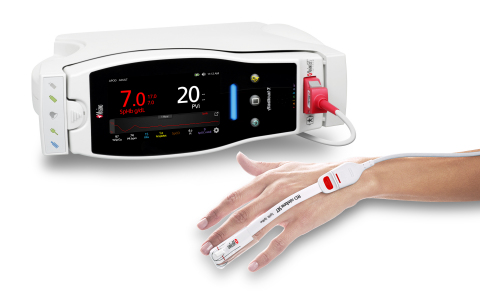Study Investigates Effects of Patient Blood Management Program with Masimo SpHb®, Noninvasive, Continuous Hemoglobin Monitoring, on Postoperative Cancer Patients
Patient Blood Management with Masimo SpHb Increased Transfusion Appropriateness and Decreased RBC Units Transfused per Patient

Masimo Radical-7® with SpHb® (Photo: Business Wire)
Neuchatel, Switzerland:
Masimo (NASDAQ: MASI) announced today the findings of a study published in Blood Transfusion in which Dr. Lucia Merolle and colleagues at the Azienda USL-IRCCS of Reggio Emilia, Italy investigated the impact of applying a patient blood management program, including use of noninvasive and continuous hemoglobin monitoring, Masimo SpHb®, to the care of postoperative cancer patients.1 The study found that using SpHb as part of a patient blood management program not only increased how often postoperative blood transfusions were appropriate, but decreased the total and mean number of blood units transfused per patient.
Patient blood management (PBM) is “an evidence-based, multidisciplinary approach aimed at optimizing the care of patients who might need blood transfusions.” Recognizing that PBM might have specific benefits for surgical oncology patients, the researchers implemented a two-step PBM program and compared three groups of postoperative adult cancer patients who underwent major surgery between 2014 and 2017. Step 1 PBM included seminars and training designed to teach semi-intensive post-surgical personnel the principles of PBM. Step 2 PBM added the use of SpHb monitored with Masimo Radical-7® Pulse CO-Oximeters® with SpHb. Audit 1 reviewed data for 200 patients whose post-surgical care did not incorporate PBM. Audit 2 was of 200 patients whose care incorporated Stage 1 PBM, and Audit 3 was of 200 patients whose care incorporated Stage 2 PBM along with continuous SpHb monitoring.
Using guidelines developed by the Italian Society of Transfusion Medicine and Immunohaematology (SIMTI), the researchers found that transfusion appropriateness rose from 38% in Audit 1 patients, to 75% in Audit 2 patients (Step 1 PBM), to 79% in Audit 3 patients (Step 2 PBM, with SpHb). The total number of red blood cell (RBC) units transfused was similar for Audit 1 and Audit 2 patients (52 and 58 units, respectively), but dropped to 39 units with the addition of SpHb monitoring to PBM (Audit 3). The mean number of RBC units transfused was the same for Audit 1 and Audit 2 patients (1.8 units/patient), but again, with the addition of SpHb monitoring (Audit 3), the mean dropped to 1.3 units/patient.
The researchers concluded, “Our PBM bundle positively impacted RBC transfusion appropriateness in post-surgical cancer patients, both in terms of quality and quantity. A structured PBM program specifically dedicated to surgical oncology should cover the entire perioperative period and might further improve transfusion appropriateness in these patients. The publication of guidelines on the management of anemia in surgical oncology should be a priority.”
In other clinical studies, continuous monitoring with SpHb as part of PBM programs has been found to improve outcomes, such as reducing the percentage of patients receiving transfusions,2 reducing the units of red blood cells transfused per patient,3-4 reducing the time to transfusion,5 reducing costs,6 and even reducing mortality 30 and 90 days after surgery by 33% and 29%, respectively.7 With the addition of the Italian study, the evidence of SpHb’s impact on outcomes spans the globe, representing 6 countries on 4 different continents.1-7 Today, SpHb technology supports clinicians in over 75 countries around the world.8
SpHb is not intended to replace laboratory blood testing. Clinical decisions regarding red blood cell transfusions should be based on the clinician’s judgment considering, among other factors, patient condition, continuous SpHb monitoring, and laboratory diagnostic tests using blood samples.
Disclaimer: This content is distributed by Business Wire India.


